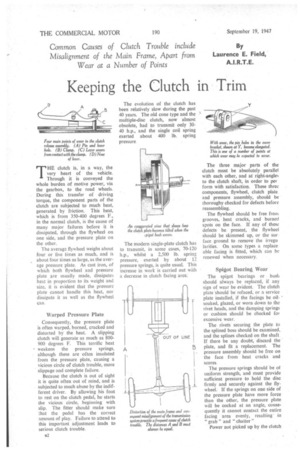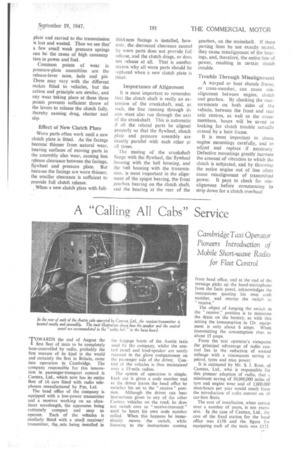Keeping the Clutch in Trim
Page 36

Page 37

If you've noticed an error in this article please click here to report it so we can fix it.
The evolution of the clutch has been relatively slow during the past 40 years. The old cone type and the multiple-disc clutch, now almost obsolete, had to transmit only 3040 h.p., and the single coil spring exerted about 400 lb. spring pressure
THE clutch is, in a way, the very heart of the vehicle. Through it is conveyed the whole burden of motive power, via the gearbox, to the road wheels. During this transfer of driving torque, the component parts of the clutch are subjected to much heat, generated by friction. This heat, which is from 350-400 degrees F., in the normal clutch, is the cause of many major failures before it is dissipated, through the flywheel on one side, and the pressure plate on the other.
The average flywheel weighs about four or five times as much, and is about four times as large, as the average pressure plate. As cast iron, of which both flywheel and pressure plate Are usually made, dissipates heat in proportion to its weight and size, it is evident that the pressure plate cannot handle this heat, nor dissipate it as well as the flywheel can.
Warped Pressure Plate Consequently, the pressure plate is often warped, burned, cracked and distorted by the heat. A slipping clutch will generate as much as 800900 degrees F. This terrific heat weakens the pressure springs, although these are often insulated from the pressure plate, causing a vicious circle of clutch trouble, more slippage and complete failure.
Because the clutch is out of sight it is quite often out of mind, and is subjected to much abuse by the indifferent driver. By allowing his foot to rest on the clutch pedal, he starts the vicious circle, beginning with slip. The fitter should make sure that the pedal has the correct amount of play. Failure to attend to this important adjustment leads to serious clutch trouble. The modern single-plate clutch has to transmit, in some cases, 70-120 h.p,, whilst a 2,500 lb. spring pressure, exerted by about 12 pressure springs, is quite usual. This increase in work is carried out with a decrease in clutch facing area The three major parts of the clutch must be absolutely parallel with each other, and at right-angles to the clutch shaft, in order to per form with satisfaction. These three components, flywheel, clutch plate and pressure assembly, should be thoroughy checked for defects before reassembling.
The flywheel should be free fron. grooves, heat cracks, and burned spots on the face. If any of these defects be present, the flywheel should be skimmed up, or the stir. face ground to remove the irregu larities. On some types a replaceable facing is fitted, which can be renewed when necessary.
Spigot Bearing Wear The spigot bearings or bush should always be replaced, if any sign of wear be evident. The clutch plate 'should be refaced, or a service plate installed, if the facings be oilsoaked, glazed, or worn down to the rivet heads, and the damping springs or cushion should be checked for excessive wear.
The rivets securing the plate to the splined boss should be examined, and the splines checked on the shaft If there be any doubt, discard the plate, and fit a replacement. The pressure assembly should be free on the face from heat cracks and scores.
The pressure springs should be of uniform strength, and must provide sufficient pressure to hold the disc firmly and securely against the flywheel: If the springs on one side of the pressure plate have more force than the other, the pressure plate will be cocked at an angle, consequently it cannot contact the entire facing area evenly, resulting in " grab " and " chatter " Power not picked up by the clutch
plate and carried to the transmission is lost and wasted. Thus we see that' a few small weak pressure springs• can be the cause of high consump tion in power and fuel.
Common points of wear in pressure-plate assemblies are the release-lever nose, hole and pin These may vary with the different makes fitted to .vehicles, but the action and principle are similar, and any wear taking place at these three points prevents sufficient throw of the levers to release the clutch fully, thereby causing drag, chatter and slip.
Effect of New Clutch Plate Worn parts often work until a new clutch plate is fitted. As the facings become thinner from natural wear, bearing surfaces of moving parts in the assembly also wear, causing less release clearance between the facings, flywheel and pressure plate. But because the facings are worn thinner, the smaller clearance is sufficient to provide full clutch release.
When a new clutch plate with full thickness facings is installed, however, the decreased clearance caused by worn parts does not provide full release, and the clutch drags, or does not release at all. That is anothel reason why all worn parts should be replaced when a new clutch plate is fitted.
Importance of Alignment It is most important to rernember that the clutch shaft is really an extension of the crankshaft, and, as such, the line running through its axis must also run through the axis of the crankshaft. This is automatic if all the related parts be aligned properly so that the flywheel, clutch plate and pressure assembly are exactly parallel with each other at all times.
The mating of the crankshaft flange with the,flywheel, the flywheel housing with the bell housing, and the bell housing with the transmission, is most important in the alignment of the spigot bearing, the front gearbox bearing on the clutch shaft, and the bearing at the rear of the gearbox, on the mainshaft. If these parting lines be not exactly mated, they cause misalignment of the bearings, and, therefore, the entire line of power, resulting in certain clutch trouble.
Trouble Through Misalignment A warped or bent chassis frame, or cross-member, can cause misalignment between engine, clutch and gearbox. BY checking the measurements on both sides of the vehicle, between the front and rear axle centres, as well as the crossmembers, hours will be saved in looking for clutch trouble actually caused by a bent frame.
It is most important to check engine mountings carefully, and to adjust and replace if necessary. Defective mountings greatly increase the amount of vibration to which the clutch is subjected, and by throwing the entire engine out of line often cause misalignment of transmitted power. It pays to check for misalignment befOre commencing to strip down for a clutch overhaul












































































